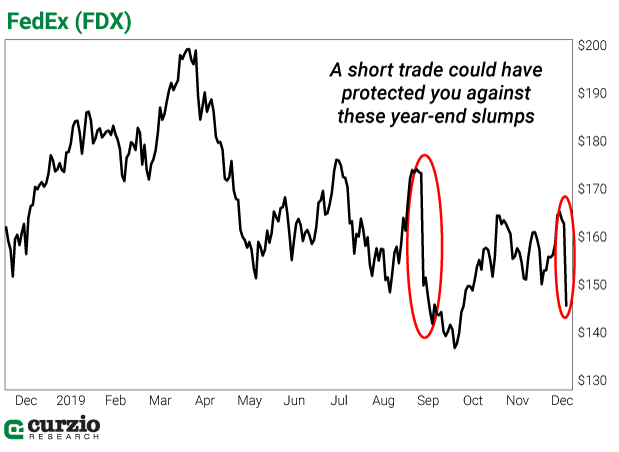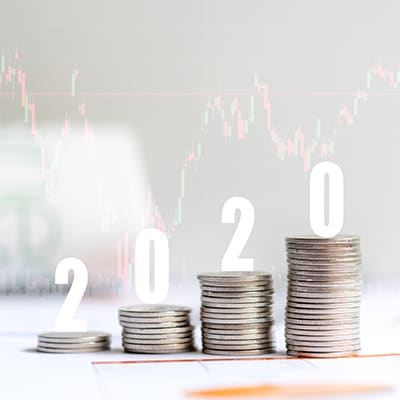The bull market may be aging, but it’s not ready to retire just yet…
Despite having already tripled from their March 2009 lows, the markets rallied to new record highs in 2019. The S&P 500 returned more than 28%. Counting dividends, this comes to over 30%.
Even so, let’s not be lulled into a false sense of security.
Past performance, as you know, is not a guarantee of future results. 2020 might be another great year—or it may be a dud. As I’ve said before in these letters, it’s important to be prepared for all eventualities.
While I don’t see the 2020 market as particularly dangerous, I also don’t expect a repeat performance for any of the major indices.
This means there will be numerous buying opportunities in the coming year—and numerous opportunities to sell stocks for profit.
I fully expect 2020 to be a stock picker’s market.
And this means it’s time to review the arsenal of tools available to us investors…
How to benefit from a negative stock outlook
If you anticipate a stock will go down, you have a variety of options:
- Avoid it
- Sell it from your portfolio (if you happen to own it)
- Take a short position (via selling the stock short or buying a put on it)
As a short seller or a put buyer, you’re making a bet that the company’s price will decline.
In other words, you’re taking action because you believe the market overestimates the company’s outlook.
This can be for a number of reasons… For instance, you expect market conditions to deteriorate by more than the consensus… you believe the company’s business faces a set of unique challenges… or you expect the stock’s recent bad news to continue impacting its long-term prospects.
The latter is the case for FedEx (FDX).
On Wednesday, December 18, FDX declined 10% after reporting lower-than-expected profits for the second quarter (Q2) of fiscal year (FY) 2020.
As you can see from the chart below, it’s not the first time this year FDX dropped sharply…

Shares dropped by double digits when the company reported FY 2020 Q1 results on September 18. The company said trade war woes (and some other factors) were impacting its bottom line.
Anyone who was pessimistic going into last week’s report could have bought a put option. Buying a put is like creating your own market insurance.
Here’s an example…
The FDX February 2020 $165 put gives you the right (but not the obligation) to sell FDX at the strike price of $165 at any time before the February 21, 2020 expiration.
On the day before the report, December 17, you could’ve bought this put for $9 per share ($900 for the minimum 100-share contract).
The next day, with profits still in a slump, the FedEx dropped 10%… And the FDX February 2020 $165 put more than doubled in price, to $19.
That’s a 110% gain in just a day, thanks to the power of leverage.
You can also take a short position if you see a set of red flags in the company’s financials.
A company that uses accounting tricks to mislead investors about growth or revenue is, generally speaking, a great short. Its shenanigans will eventually come to bite it—and its investors.
If you’ve never placed a short position before, it’s easier than you think. I explain how here.
How to benefit from a positive stock outlook
Many stocks will have significant upside in 2020.
Some—like the many tech or homebuilding companies that did well in 2019—will continue their bull run into next year.
Others will look like bargains after a disappointing 2019… This may include FDX, which only lost one bullish analyst on the heels of its Q2 report… or Boeing (BA), where the grounding of the 737 MAX may have already been baked into the share price.
Once you’ve decided to bet on a stock’s upside, you have two alternatives:
- Buy the stock outright
- Buy a call option
Buying the stock outright is the easiest and the most common.
Buying a stock (or “going long”) has its advantages. This method doesn’t require a margin account and the trade doesn’t expire (like all options do).
If you own a stock, you profit when it moves higher. (You’ll also collect a dividend if the company pays one.)
Unlike selling short, which has unlimited loss potential (in theory, there’s no upper limit on a stock’s gains), a loss on a long position is limited to the amount invested.
The other way to bet on a stock’s upside is to buy a call option. This would give you the right (but not the obligation) to buy a stock at a predetermined price within a specific time frame.
When you buy a call option, you expect the stock in question to move higher—it’s a quintessential bull trade.
Plus, if you buy a call, you create a leveraged position. Because of the leverage, your profits per every invested dollar can be much higher than when you opt for simply buying the stock.
Of course, the risks are higher, too; just like a put, a call option can expire worthless if the market goes against you. And you can lose with call options if your expected price move doesn’t happen within the time frame of the trade.
Buying a call creates the potential for massive percentage gains—because a stock can move dramatically higher within a very short period of time. And the risks are strictly limited to the cost of the call.
Most investors own a portfolio of long positions—it’s the easiest and the most straightforward way to benefit from a long-term market outlook. But knowing all your options (pardon the pun) will help you stand out from the crowd—and benefit from all conditions.
Here’s to a happy, healthy, and wealthy New Year!

 | Genia Turanova Editor, Moneyflow Trader |





















